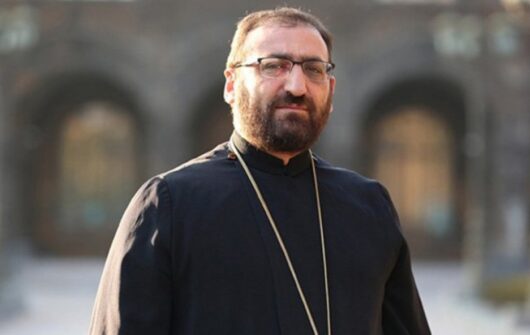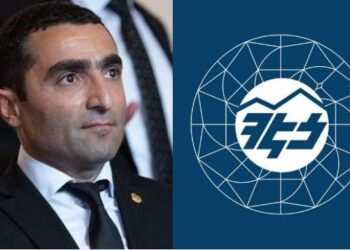By Mihran Aroian
Special to the Mirror-Spectator
Last week, I had an opportunity to attend a lecture by Alar Karis, the president of Estonia. After attending meetings at the United Nations, President Karis came to Austin for the opening of the U.S. headquarters of two Estonian companies, Clevon and EyeVi Technology. As a former Soviet Republic, Estonia has become the poster child for the greatest economic success story from the dissolution of the USSR. I wanted to learn why Estonia, with a population of 1.3 million, half the population of Armenia, has a Gross Domestic Product (GDP) that is three times that of Armenia and an average income of five times Armenia. Both Armenia and Estonia declared independence in 1991, yet they have been on very different economic paths.
Estonia is not a country that I have given much thought to over the years. If you have every used the video conferencing program Skype, this was originally created in Estonia before being purchased by Microsoft. Estonia’s neighbors are Finland, Sweden, Latvia, and a 200-mile border with Russia. What a fascinating story President Karis shared on how Estonia immediately upon independence invested in their people and infrastructure. Today, Estonia is known for their embrace of the digital revolution. Part of their branding is that they consider themselves the first “Digital Republic,” claiming that 99 percent of public services are digitized. President Karis asserts that virtually everything that can be done electronically is performed electronically, except for marriage and divorce.
No question digitizing public services in Armenia will certainly be helpful as well as save time and money. However, this does not explain why Estonia has been so successful. I believe it really comes down to two main factors. Estonia is geographically located in Europe, and when they looked west for economic motivation, they embraced the EU and the European mentality. Armenia never had such an opportunity, and if you look at Armenia’s neighbors, they are far from shining economic examples. You can make that same argument about Israel, except that the political strength of the Israeli diaspora has been a key point of differentiation, which Armenia needs to improve upon as discussed later.
The other factor in favor of Estonia is the opposite level of corruption that Armenia has endured over the decades. While Estonia was heavily investing in their infrastructure and people, Armenia was still following the Soviet model of corruption, oligarchs, and generating wealth for the few. Obtaining verifiable figures is difficult but it is estimated that former Armenian President Robert Kocharyan has a net worth of $4 billion and former President Serzh Sargsyan has an estimated net worth north of $300 million. In comparison, the four former presidents of Estonia: Lennart Meri, Arnold Rüütel, Toomas Hendrik Ilves, and Kersti Kaljulaid have a combined estimated net worth of about $8 million.
One other obvious distinction is that Estonia has the protection of NATO. Armenia, as we have all learned the hard way, has no real military allies. Yet Russia has the 102nd Military Base in Gyumri with an estimated 10,000 soldiers, but that seems to be yielding little value to Armenia as witnessed in recent times.
Agriculture, mining, and tourism still make up most of the Armenian economy and, although the IT industry is the bright star in Armenia, unemployment is still 20 percent. In fact, it is estimated that some 15-20 percent of Armenians go to Russia to find work. We, in the diaspora, have little ability to change the geopolitical climate of Armenia. Apart from Georgia, who has never been an Armenian ally, our neighbors are far more powerful with resources unavailable to Armenia.
Some wonderful recent news is that the Armenian economy is likely the best it has been in years, primarily because of all the Russians who have migrated into Armenia since the war in Ukraine. A significant portion are IT workers who have real income. We cannot change the past, but Armenia needs to change its future trajectory. If Armenia pins its survival and economic hopes on Russia, the EU, or even the U.S., we will only be disappointed with the outcome. If we are honest with ourselves, what real economic value do we offer to the world today? That must change and change soon if Armenia is to thrive. And the good news is that it is within our power.
Our focus needs to be on what can the diaspora do to help Armenia help itself. We cannot fix all the ailments of Armenia from the diaspora, but we can be an important part of the solution. With all that you hear about the Armenian diaspora, it is still an underutilized and unrealized asset. It’s not about sending more donations or money – it’s about being the engine to building Armenia economically. It comes down to one key factor – economic development. This is something that the diaspora can do from anywhere and if those who have the wherewithal to help do their small part, together, we can move Armenia from linear growth to logarithmic growth.
For those of you reading who are thinking about improving education, health care, military capabilities and social services – those are all important needs, but our ability to affect them from the diaspora are limited. Improving the Armenian economy will help raise all levels in Armenia. The important question is how to do this in a manner that is highly efficient and effective. From time to time, I have helped a young company or two in Armenia. I’m not alone as I have known many people who have used their skills and talents to help an Armenian enterprise. The question is how to do this better and on a larger scale. How do we bring together the right person from the diaspora who can help an Armenian enterprise and can we institutionalize this as a repeatable and scalable process?
There are a number of venture capital firms and incubators in Armenia. Granatus Ventures and Hive Ventures have been active investors in Armenia for years. Impact Hub, FAST Foundation, and EPIC have been active incubators in Armenia. Many resources are available — if you know where to look. Armenia needs to develop a value chain from research to market to bring the most advanced solutions to the world. Despite the increase of multinational firms, the linkages between research and industry are not prevalent. The few linkages that have worked are based on personal connections rather than an institutional approach. What is missing is a centralization where all resources that an Armenian entrepreneur or business needs can be accessed.
By bringing together our collective resources, we can increase the efficiency by which an Armenian businessman can gain access to industry experts in the diaspora, or access to new markets. Whatever we can do to increase the interaction between Armenians who have expertise and knowledge about a particular industry or market segment can provide introductions and assistance to those firms in Armenia that are looking for those resources. At some point, Armenia will need a technology transfer office in the EU and US, with intellectual property expertise to help facilitate the commercialization of Armenian technology. Having Armenian professional associations in the diaspora is a good starting place. Imagine if we could harness the power of 10 percent of the Armenian diaspora in helping Armenian businesses? The results would be phenomenal. The time is now!
Mihran Aroian teaches in the McCombs School of Business at The University of Texas at Austin and is a regular guest lecturer in the MBA program at the American University of Armenia, Yerevan.
The Armenian Mirror-Spectator








